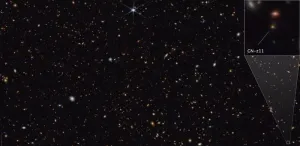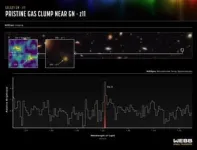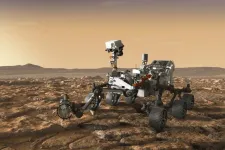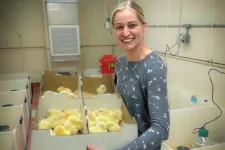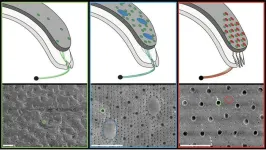(Press-News.org) Looking deeply into space and time, two teams using NASA’s James Webb Space Telescope have studied the exceptionally luminous galaxy GN-z11, which existed when our 13.8 billion-year-old universe was only about 430 million years old.
Initially detected with NASA’s Hubble Space Telescope, this galaxy — one of the youngest and most distant ever observed — is so bright that it is challenging scientists to understand why. Now, GN-z11 is giving up some of its secrets.
Vigorous Black Hole Is Most Distant Ever Found
A team studying GN-z11 with Webb found the first clear evidence that the galaxy is hosting a central, supermassive black hole that is rapidly accreting matter. Their finding makes this the farthest active supermassive black hole spotted to date.
“We found extremely dense gas that is common in the vicinity of supermassive black holes accreting gas,” explained principal investigator Roberto Maiolino of the Cavendish Laboratory and the Kavli Institute of Cosmology at the University of Cambridge in the United Kingdom. “These were the first clear signatures that GN-z11 is hosting a black hole that is gobbling matter.”
Using Webb, the team also found indications of ionized chemical elements typically observed near accreting supermassive black holes. Additionally, they discovered a very powerful wind being expelled by the galaxy. Such high-velocity winds are typically driven by processes associated with vigorously accreting supermassive black holes.
“Webb’s NIRCam (Near-Infrared Camera) has revealed an extended component, tracing the host galaxy, and a central, compact source whose colors are consistent with those of an accretion disk surrounding a black hole,” said investigator Hannah Übler, also of the Cavendish Laboratory and the Kavli Institute.
Together, this evidence shows that GN-z11 hosts a 2-million-solar-mass, supermassive black hole in a very active phase of consuming matter, which is why it's so luminous.
Pristine Gas Clump in GN-z11’s Halo Intrigues Researchers
A second team, also led by Maiolino, used Webb’s NIRSpec (Near-Infrared Spectrograph) to find a gaseous clump of helium in the halo surrounding GN-z11.
“The fact that we don't see anything else beyond helium suggests that this clump must be fairly pristine,” said Maiolino. “This is something that was expected by theory and simulations in the vicinity of particularly massive galaxies from these epochs — that there should be pockets of pristine gas surviving in the halo, and these may collapse and form Population III star clusters.”
Finding the never-before-seen Population III stars — the first generation of stars formed almost entirely from hydrogen and helium — is one of the most important goals of modern astrophysics. These stars are anticipated to be very massive, very luminous, and very hot. Their expected signature is the presence of ionized helium and the absence of chemical elements heavier than helium.
The formation of the first stars and galaxies marks a fundamental shift in cosmic history, during which the universe evolved from a dark and relatively simple state into the highly structured and complex environment we see today.
In future Webb observations, Maiolino, Übler, and their team will explore GN-z11 in greater depth, and they hope to strengthen the case for the Population III stars that may be forming in its halo.
The research on the pristine gas clump in GN-z11’s halo has been accepted for publication by Astronomy & Astrophysics. The results of the study of GN-z11’s black hole were published in the journal Nature on January 17, 2024. The data was obtained as part of the JWST Advanced Deep Extragalactic Survey (JADES), a joint project between the NIRCam and NIRSpec teams.
The James Webb Space Telescope is the world’s premier space science observatory. Webb is solving mysteries in our solar system, looking beyond to distant worlds around other stars, and probing the mysterious structures and origins of our universe and our place in it. Webb is an international program led by NASA with its partners, ESA (European Space Agency) and the Canadian Space Agency.
END
Webb unlocks secrets of one of the most distant galaxies ever seen
2024-03-04
ELSE PRESS RELEASES FROM THIS DATE:
3D-printed skin closes wounds and contains hair follicle precursors
2024-03-04
UNIVERSITY PARK, Pa. — Fat tissue holds the key to 3D printing layered living skin and potentially hair follicles, according to researchers who recently harnessed fat cells and supporting structures from clinically procured human tissue to precisely correct injuries in rats. The advancement could have implications for reconstructive facial surgery and even hair growth treatments for humans.
The team’s findings published today (March 1) in Bioactive Materials. The U.S. Patent and Trademark ...
Discovered a RNA molecule that helps prevent DNA replication errors
2024-03-04
Researchers at Cima Universidad de Navarra have discovered that a ribonucleic acid that does not contain information to make proteins (long non-coding RNA) plays a crucial role in signalling and repairing errors in DNA replication during cell division. This finding could lead to the development of new anti-tumour therapies.
Scientists have identified an RNA that they named 'lncREST' (long non-coding RNA REplication STress) and uncovered its role in triggering an effective response to the stress induced by rapid cell division. "LncREST localises ...
Small and overlooked: Amount of repetitive DNA in blood hints at cancer early
2024-03-04
FOR IMMEDIATE RELEASE
People with cancer have different amounts of a type of repetitive DNA — called Alu elements — than people without cancer. Now, machine learning can measure that from a blood draw. Researchers at the Johns Hopkins Kimmel Cancer Center have used this finding to improve a test that detects cancer early, validating and reproducing the results by starting with a sample size tenfold larger than typical of such types of studies.
The research was published Jan. 24 in the journal Science Translational Medicine.
Alu ...
Study determines the original orientations of rocks drilled on Mars
2024-03-04
As it trundles around an ancient lakebed on Mars, NASA’s Perseverance rover is assembling a one-of-a-kind rock collection. The car-sized explorer is methodically drilling into the Red Planet’s surface and pulling out cores of bedrock that it’s storing in sturdy titanium tubes. Scientists hope to one day return the tubes to Earth and analyze their contents for traces of embedded microbial life.
Since it touched down on the surface of Mars in 2021, the rover has filled 20 of its 43 tubes with cores of bedrock. Now, MIT geologists have remotely determined a crucial property of the rocks collected to date, which will help scientists answer key questions about the planet’s ...
Illinois study: Supporting disease-challenged broiler chickens through nutrition
2024-03-04
URBANA, Ill. — When broiler chickens are busy fighting the parasitic infection coccidiosis, they can’t absorb nutrients efficiently or put energy toward growth. With consumer sentiment pitted against antimicrobials and other drugs, producers still have some options to ensure optimal growth during inevitable outbreaks. New research from the University of Illinois Urbana-Champaign suggests diet changes might help.
“Vaccines and anticoccidials are the traditional ways to prevent this disease. Nutrition can't replace all of the pharmaceuticals, but it can be supportive in providing care,” said senior study author Ryan Dilger, ...
Communities severed by roads and traffic experience a larger number of collisions in New York City
2024-03-04
March 4, 2024- New York City neighborhoods with disrupted community connections, due to traffic, roads, and transport infrastructure, are experiencing an increase in traffic collisions. This increase is seen both in total collisions and for those in which pedestrians or cyclists are injured or killed, according to a new study from Columbia University Mailman School of Public Health. The findings are reported in the journal Environment International.
“Despite recent remarkable progress, road safety remains an urgent urban issue in New York and other U.S. cities. It is important to understand how the spatial configuration of the city enhances ...
Study shows new class of antivirals that works against SARS-CoV-2
2024-03-04
EDMONTON — A University of Alberta research team has uncovered a new class of drugs with the potential to prevent or treat infections in a future viral outbreak.
In the paper, published this week in Nature, the team reports that SARS-CoV-2 — the virus that causes COVID-19 — activates a pathway in cells that stops the production of peroxisomes and interferon, key parts of the normal immune response. The team successfully tested a new class of antiviral drugs that stimulate interferon production to reverse that effect.
Tom ...
Cost of direct air carbon capture to remain higher than hoped
2024-03-04
Switzerland plans to reduce its net carbon emissions to zero by no later than 2050. To achieve this, it will need to drastically reduce its greenhouse gas emissions. In its climate strategy, the Swiss government acknowledges that some of these emissions, particularly in agriculture and industry, are difficult or impossible to avoid. Swiss climate policy therefore envisages actively removing 5 million tonnes of CO2 from the air and permanently storing it underground. By way of comparison, the Intergovernmental ...
Unraveling the mystery of chiton visual systems
2024-03-04
(Santa Barbara, Calif.) — You’d probably walk past a chiton without even seeing it. These creatures often look like nothing more than another speck of seaweed on the crusty intertidal rocks. But it sees you. At least, if it’s one of the species with eyes dotting its platemail shell.
A team of scientists — led by Rebecca Varney at UC Santa Barbara’s Department of Ecology, Evolution, and Marine Biology (EEMB) — discovered that some of these tough mollusks sport the most recently evolved eyes with a lens. What’s more, the ...
Case Western Reserve University-led research team discovers new method to test for oral cancer
2024-03-04
CLEVELAND—Oral cancers and precancerous mouth lesions are considered especially difficult to diagnose early and accurately.
For one, biopsies are expensive, invasive, stressful for the patient and can lead to complications. They’re also not feasible if repeated screenings of the same lesion are required.
But a team of researchers, led by a clinician scientist at the Case Western Reserve University School of Dental Medicine, has discovered a noninvasive, low-cost test to detect oral cancer, monitor precancerous lesions and determine when a biopsy is warranted.
Their findings, published ...
